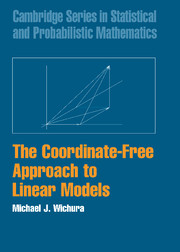Preface
Published online by Cambridge University Press: 23 November 2009
Summary
When I was a graduate student in the mid-1960s, the mathematical theory underlying analysis of variance and regression became clear to me after I read a draft of William Kruskal's monograph on the so-called coordinate-free, or geometric, approach to these subjects. Alas, with Kruskal's demise, this excellent treatise will never be published.
From time to time during the 1970s, 80s, and early 90s, I had the good fortune to teach the coordinate-free approach to linear models, more precisely, to Model I analysis of variance and linear regression with nonrandom predictors. While doing so, I evolved my own set of lecture notes, presented here. With regard to inspiration and content, my debt to Kruskal is clear. However, my notes differ from Kruskal's in many ways. To mention just a few, my notes are intended for a one- rather than three-quarter course. The notes are aimed at statistics graduate students who are already familiar with the basic concepts of linear algebra, such as linear subspaces and linear transformations, and who have already had some exposure to the matricial formulation of the GLM, perhaps through a methodology course, and who are interested in the underlying theory. I have also included Tjur experimental designs and some of the highlights of the optimality theory for estimation and testing in linear models under the assumption of normality, feeling that the elegant setting provided by the coordinate-free approach is a natural one in which to place these jewels of mathematical statistics.
- Type
- Chapter
- Information
- The Coordinate-Free Approach to Linear Models , pp. xi - xivPublisher: Cambridge University PressPrint publication year: 2006



